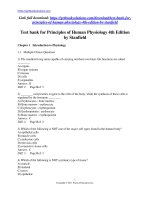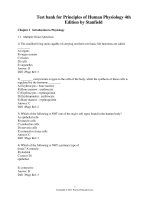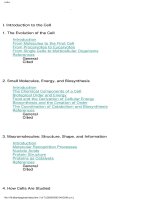Essentials of animal physiology 4th ed s c rastogi (new age, 2007)
Bạn đang xem bản rút gọn của tài liệu. Xem và tải ngay bản đầy đủ của tài liệu tại đây (6.55 MB, 597 trang )
This page
intentionally left
blank
Copyright © 2007, 2001, 1988, 1977 New Age International (P) Ltd., Publishers
Published by New Age International (P) Ltd., Publishers
All rights reserved.
No part of this ebook may be reproduced in any form, by photostat, microfilm,
xerography, or any other means, or incorporated into any information retrieval
system, electronic or mechanical, without the written permission of the publisher.
All inquiries should be emailed to
ISBN : 978-81-224-2429-4
PUBLISHING FOR ONE WORLD
NEW AGE INTERNATIONAL (P) LIMITED, PUBLISHERS
4835/24, Ansari Road, Daryaganj, New Delhi - 110002
Visit us at www.newagepublishers.com
Preface to the
Fourth Edition
The Essentials of Animal Physiology has established itself with the academia and served (a) as a text
for courses in animal physiology for B.Sc. (Hons.) and B.Sc.(Pass) courses, and (b) as a sound basis
for laboratory investigations to analyse animal functions.
Physiology is a synthetic and experimental science which applies physical and chemical methods
in biology. It requires a combination of field and laboratory observations of organisms, since their life
is influenced by a variety of environmental factors. This fourth edition, wholly reset in its new format,
has provided an opportunity for detailed scrutiny and extensive revision. However, the principles of
physiology stated in the earlier editions remain sound.
The revision has been impacted by two considerations: these are updating the existing text and
adding exciting developments in the field to enhance the utility of the book for an enlarged
readership. Consequently, this edition contains new chapters on animal calorimetry, membrane
physiology and physiological disturbances emanating from organellar malfunctions and genetic
disorders. Besides, certain sections of metabolism and physiology of digestion have been revised to
provide new insights. It must be appreciated that physiology offers rational basis for much of
medicine, home science and animal husbandry.
It must be emphasised that an effective way of administering a physiology course is to
simultaneously plan laboratory exercises to unravel the exciting physiological phenomena. For this
the reader is advised to refer Experimental Physiology (New Age Publishers), by the same author.
This edition has been reinforced by providing more multiple choice questions for self-assessment.
I hope the book will be more appealing to students and instructors in terms of contents and
presentation.
S.C. Rastogi
This page
intentionally left
blank
Preface to the
First Edition
Every year, during one semester, I am engaged in the teaching of physiology to senior students. I have
often felt the difficulty to cover all areas of physiology owing to deficiency in the background
knowledge of students. With the result certain fundamental topics are left uncovered or inadequately
treated. In addition, the subject of physiology has recently grown so rapidly that it is impossible for
the average student to tread the vast field. Therefore, I felt the necessity of writing this book with the
hope that it would cater to the needs of both the categories of studentsthose who want to study
physiology in its essentials, and also those who wish to acquaint themselves with the major areas and
latest developments in the field.
While writing the book, I realized that with the development of the core curricula of different
universities at various levels of instruction, the presentation of the subject should provide all essential
aspects related to it. Still, limits had to be imposed on its treatment since the purpose was not to write
a comprehensive treatise. In fact, the objective was to initiate the student in the study of the subject
and at the same time to prepare a book that would meet the requirements of various syllabi. Human
physiology has been surveyed at appropriate places without exhaustive treatment.
The book is divided into 18 chapters which are arranged in a fashion that the reader can develop
his ideas step by step. The subject matter gives a comprehensive coverage to such essential areas as
the structure of cells and their function, foodstuffs, digestion and absorption, biological oxidations,
metabolism, water relations and ionic regulations, temperature regulation, body fluids and their role,
circulation of blood, respiration, excretion, nerve physiology, sensory mechanisms, nerve
coordination, effector organs, hormonal regulation, reproduction, and physiological genetics. The
discussion of each area is intended to provide an understanding of important facts drawn from
relatively new and up-to-date sources that will stimulate students interest. The book can be profitably
used by them whether they are specializing in areas of zoology, veterinary or human medicine, or
nutrition.
Perhaps it is not customary to begin a book on animal physiology with a chapter on cell structure
and function as has been done in the present case. The cell forms the basic unit of life and all physico-
LEEE
Preface to the First Edition
chemical and vital life functions were first discovered at the cell level and later extended to the
organismic level. I consider it difficult, if not impossible, to understand the functioning of the whole
organism without a good knowledge of the fundamental processes at the cellular level. One way of
trying to understand a complex system is to formulate a model that exhibits the same properties as are
found in the entire organismthat model being the cell. Keeping this in mind I have decided to
include this chapter which, I believe, will enchance the character of the book in its broad-based bias.
The chapter on foodstuffs is comprehensive and highlights chemical details to emphasize the
important point, viz. the various types of food eaten by animals are used as fuels for the generation of
energy explainable in chemical terms. Chemical details are necessary to explain their functional
significance. The types of food and their chemical composition should be an important piece of
information to the students to enable them to know as to how animals obtain their energy
requirements from the complex foodstuffs. A chapter on biological oxidations has been included.
Biology students have a tendency to ignore this area which is very much a part of physiology essential
to the strengthening of the basic concepts. It was thought that the initial approach to physiology must
be to analyse physiological processes in terms of chemical reactions from the point of view of
energetics.
Relevant biochemical details are given to the extent they are necessary. The aim was to explain
rather than to describe principles of animal physiology, and therefore, in some parts I have leaned on
biochemistry to achieve this end. The pertinence of many areas will be quite obvious. At appropriate
places, experimental details have been given in support of the factual statements and hypotheses. The
bibliography will be helpful to an alert student interested in more details about the subject.
In a work like this, it is impossible to accomplish the task without the encouragement and
invaluable help of many. I, therefore, wish to thank Dr. C.R. Mitra, Director of the Institute; Professor
V. Krishnamurty and T.S.K.V. Iyer for the much needed encouragement through the preparation of the
book. A text of this type would not be possible without the aid of specialists in the field. Accordingly
I wish to thank Professors H.S. Chaudhury (Gorakhpur University), R. Nagbhushanam (Marathwada
University) and V.P. Agarwal (D.A.V. College, Muzaffarnagar, Meerut University) who served as
members of the University Grants Commission editorial committee, and the reviewer of the National
Book Trust. They have read the entire manuscript with meticulous care and offered valuable
comments and excellent suggestions about the subject matter. On the basis of the reviewers
comments, substantial additions have been made in the textual matter resulting in rewriting a large
part of the manuscript. With the result, the first draft has been thoroughly revised and enlarged.
Although I have gratefully adopted many of their suggestions, yet I have sometimes preferred my own
viewpoint as well.
I appreciate Dr. H.L. Kundus sincere cooperation which I have always enjoyed in abundance. I
also acknowledge the assistance extended by Dr. M. Ramakrishna, who was associated with the
project for some time, in writing Chapters 1 to 3.
Most particularly, I am grateful to the University Grants Commission for financial assistance
under its Book Writing Project sanctioned to me for the duration January 1973 to August 1975,
without which this book could not have taken shape. However, Chapters 16 to 18 were written after
the termination of the project. My sincere thanks are also due to Dr. V.N. Sharma for his valuable help
Preface to the First Edition
EN
in the preparation of bibliography, index and some diagrams included in the text. I am grateful to him
for his constructive criticism of Chapters 17 to 18. My special thanks are due to Professor S.C. Shukla
for his advice on specific points while checking some sections of the manuscript.
Pilani
December 1, 1976
S.C. Rastogi
This page
intentionally left
blank
Contents
Preface to the Fourth Edition
Preface to the First Edition
v
vii
1. Cell Structure and Function
1.1 General Structure of Cell
1.2 Plasma Membrane
1.3 Endoplasmic Reticulum
1.4 Golgi Apparatus
1.5 The Lysosome System
1.6 Mitochondria
1.7 Centriole
1.8 Nucleus
1
2
4
8
10
13
16
19
20
2. Foodstuffs
2.1 Carbohydrates
2.2 Proteins
2.3 Lipids
2.4 Vitamins
2.5 Minerals and Water
25
25
30
39
47
56
3. Biological Oxidations
3.1 Bioenergetics
3.2 Types of Reactions
3.3 Coupled Reactions
3.4 Energy Expenditure in Metabolic Processes
65
65
67
68
70
NEE
Contents
3.5
3.6
3.7
3.8
3.9
3.10
Oxidation-Reduction Reactions
The Cytochrome System
The Flavoproteins
Dehydrogenation
Energy Release and Oxidative Phosphorylation
Glucose Oxidation
71
72
73
74
75
75
4. EnzymesThe Biological Catalysts
4.1 General Properties of Enzymes
4.2 The Mechanism of Enzyme Action
4.3 Classification of Enzymes
4.4 Factors Influencing Enzyme Activity
4.5 Isoenzymes
4.6 Allosteric Enzymes
4.7 Coenzymes
79
79
82
85
86
90
90
91
5. Animal Calorimetry
5.1 Animal Calorimetry
5.2 Basal Metabolism
5.3 Caloric Requirement
93
93
96
98
6. Metabolism
6.1 Oxidation of Amino Acids
6.2 Urea Synthesis
6.3 Decarboxylation
6.4 Reactions of Some Amino Acids
6.5 Metabolism of Creatine and Creatinine
6.6 Sulphur Metabolism
6.7 Metabolism of Nucleoprotein
6.8 Blood Sugar
6.9 Glycolysis
6.10 Glycogenesis
6.11 Gluconeogenesis
6.12 Muscle Glycogen
6.13 Metabolism of Other Sugars
6.14 Role of Liver in Fat Metabolism
6.15 Oxidation of Fatty Acids
6.16 >-Oxidation of Fatty Acids
6.17 Metabolism of Glycerol
100
101
102
102
103
104
104
105
108
109
111
111
112
112
113
114
115
118
Contents
6.18
6.19
6.20
6.21
Synthesis of Glycerides and Fatty Acids
Metabolism of Phospholipids
Metabolism of Cholesterol
Ketogenesis
NEEE
118
119
119
121
7. Digestion and Absorption
7.1 Modes of Nutrition
7.2 Intake of Food Materials
7.3 Digestion of Foodstuffs
7.4 Digestion in Mammals
7.5 Digestion in Other Vertebrates
7.6 Digestion in Invertebrates
7.7 Carbohydrate Absorption
7.8 Protein Absorption
7.9 Absorption of Fat
7.10 Absorption of Other Substances
124
124
125
127
132
144
145
146
148
149
150
8. Water Relations and Ionic Regulations
8.1 Role of Membranes in Osmotic and Ionic Regulations
8.2 Some Definitions
8.3 Aquatic and Terrestrial Habitats
8.4 Probable Movements of Animals Between Different Environments
8.5 Role of Body Fluids
8.6 Adaptation to Marine Habitat
8.7 Adaptations to Brackish Water Habitat
8.8 Adaptation to Freshwater Habitat
8.9 Adaptations to Terrestrial Habitat
8.10 Return to the Sea
154
155
162
164
165
168
169
171
174
175
178
9. Membrane Physiology
9.1 Chemical Composition of Membranes
9.2 Membrane Architecture
9.3 Membrane Transport Functions
9.4 Mechanisms for Transport of Materials Across Membranes
9.5 Bulk Transport Systems
182
182
186
191
193
198
10. Temperature Regulation
10.1 Habitats of Animals
10.2 Nomenclature of Thermoregulation
10.3 Energy Relationships of Animals
203
203
204
205
NEL
10.4
10.5
10.6
10.7
10.8
10.9
10.10
Contents
Low Temperature Effects
Temperature Relations in Poikilotherms
Temperature Relations of Homotherms
Temperature Relations of Heterotherms
Thermoregulatory Control Centre
Temperature Regulation in Endotherms
Acclimatization
206
207
210
212
213
214
218
11. Body Fluids
11.1 Major Types of Body Fluids
11.2 Blood
11.3 General Properties of Blood
11.4 Composition of Blood
11.5 Formed Elements of Blood
11.6 Blood Groups and Transfusions
11.7 Coagulation of Blood
11.8 Theories of Coagulation
11.9 Haemolysis
11.10 Haematological Abnormalities
220
220
221
222
223
226
232
237
239
240
242
12. Circulation of Blood
12.1 The Blood Volume
12.2 The Components of Circulatory System
12.3 Heart of Invertebrates
12.4 Heart of Vertebrates
12.5 Physiological Properties of Cardiac Muscles
12.6 Regulation of the Heart
12.7 Chemical Regulation
244
245
245
246
247
248
257
261
13. Respiration
13.1 Respiratory Devices
13.2 Mechanism of Breathing
13.3 Respiratory Pigments
13.4 Properties of Respiratory Pigments
13.5 Factors Affecting Oxygen Dissociation
13.6 Transport of Carbon Dioxide
13.7 Buffer Systems of Blood
13.8 Acid-Base Disturbances of Respiratory Origin
13.9 Acid-Base Disturbances of Non-respiratory Origin
263
264
268
270
272
273
276
277
279
280
Contents
13.10 Regulatory Processes in Respiration
NL
280
14. Excretion
14.1 Organs of Excretion
14.2 Types of Excretory Products
14.3 Patterns of Excretion
14.4 Changes in Nitrogen Excretion with Life Cycle
14.5 Dietary Influence on Nitrogen Excretion
14.6 Excretory Devices in Invertebrates
14.7 Excretion Devices in VertebratesRenal Physiology
14.8 Composition of Urine
14.9 Countercurrent Mechanism
14.10 Acid-Base Regulation
14.11 Renal Control Mechanisms
285
285
286
291
293
294
294
296
304
306
307
309
15. Nerve Physiology
15.1 Units of the Nervous System
15.2 Irritability
15.3 Electrical Phenomena of Nerves
15.4 Theories of Excitation
15.5 Factors Influencing Excitation and Propagation
15.6 Impulse Propagation
15.7 Synaptic Transmission
311
312
315
316
324
325
326
330
16. Sensory Mechanisms
16.1 Classification of Receptors
16.2 Chemoreceptors
16.3 Mechanoreceptors
16.4 Radioreceptors
334
334
335
338
347
17. Nervous Coordination
17.1 Integration
17.2 Synaptic Integration
17.3 Types of Reflexes
17.4 Classification of Reflexes
354
355
355
359
361
18. Effector Organs
18.1 Animal Movement
18.2 Structure of Muscles
18.3 Composition of Muscles
371
371
372
374
NLE
18.4
18.5
18.6
18.7
18.8
18.9
18.10
18.11
18.12
18.13
Contents
Neuromuscular Junction
Excitability of Muscle Tissue
Muscle Contraction
Theories of Contraction
Chemical Basis of Contraction
Bioelectrogenesis
Bioluminescence
Chemistry of Bioluminescence
Colour Production
Mechanism of Action of Chromatophores
377
378
379
388
390
394
395
396
400
402
19. Hormonal Regulation
19.1 The Pituitary
19.2 The Pancreas
19.3 Hormonal Control of Growth
19.4 Hormonal Control of Ionic and Water Balance
19.5 Prostaglandins
19.6 Hormonal Regulation in Invertebrates
404
410
425
427
427
429
430
20. Reproduction
20.1 Levels of Reproduction
20.2 Patterns of Reproduction
20.3 Morphology of the Reproductive Organs
20.4 Breeding Cycles
20.5 Hormonal Control of Sex and Reproduction
20.6 Hormonal Control in Females
20.7 Gonadal Hormones
20.8 Puberty
20.9 Estrous Behaviour
20.10 Ovulation
20.11 Sperm Transport in the Female Genital Tract
20.12 Implantation
20.13 Placentation
20.14 Parturition
20.15 Lactation
435
435
436
437
443
444
444
446
448
449
452
453
454
455
456
458
21. The Genetic Code and Protein Synthesis
21.1 The Organization of the Chromosome
21.2 Replication of DNA
461
462
463
Contents
21.3 The Genetic Code
21.4 Synthesis of Polyribonucleotides
21.5 Protein Synthesis
NLEE
467
467
471
22. Physiologic Disorders
22.1 Organelle Malfunction
22.2 Metabolic Disorders
478
478
483
23. Physiological Genetics
23.1 The Gene as a Functional Unit
23.2 Control of Metabolic Processes
23.3 Nucleus-Cytoplasmic Interaction
23.4 Transplant Experiments
23.5 Genetic Control of Eye Pigments
23.6 Genic Control of Development
23.7 Effects of Gene Mutations
23.8 Inborn Errors of Metabolism: Genic Defects
486
486
487
490
492
493
495
497
498
24. Immune System
24.1 Types of Immunity
24.2 What are Antigens?
24.3 Types of Immunoglobulins
24.4 Lymphocytes and the Lymphatic System
24.5 Antigen-Antibody Interaction
24.6 Transplantation Immunity
24.7 Allergy
502
502
503
504
507
509
516
519
25. Physiology of Aging
25.1 Aging at Cellular Level
25.2 Aging at the Molecular Level
25.3 Aging of Connective Tissue
25.4 Aging and Immunological Surveillance
25.5 Mental Aspects of Aging
25.6 Theories of Aging
521
521
523
526
527
528
528
Self Assessment Questions (SAQs)
532
Review Questions
550
Bibliography
561
Index
567
This page
intentionally left
blank
+0)26-4
Cell Structure and
Function
Every multicellular organism is composed of cells, which are the basic units of life. The cell can be
likened to a factory. A factory has several machines which are linked to one another in specific order
and each one makes a particular component. By sequential operations, the components from these
machines are, assembled to produce the desired products. Similarly the cellular constituents, each
with their specific function, have a definite arrangement. They produce the components, in this case
molecules, which are assembled to synthesize the required products (macromolecules). The function
of the organism as a whole is the result of the combination of activities and interactions of the cell
units in its body. Hence to understand the essential physiology of animals we need to know the
physiological functions of the cellthe cell which is a fundamental unit of life.
The living cell performs all the functions of life such as intake of nutrients, metabolism, growth,
reproduction, etc. To perform these life activities the cell has in it various cellular constituents or
organelles.
Our knowledge of the structure and function of the cellular constituents has greatly increased
with the development of electron microscope by Knoll and Ruska in 1933 and the centrifuge by
Swedberg in 1924.
Electron microscope became available in 1940. It paved the way for a more specific knowledge
of the cell structure and the structure of organelles within the cell. It permits magnifications of
1,000,000 times or more, i.e. down to the molecular dimensions. It has revealed the strict and orderly
patterns of arrangement of macromolecules constituting the organelles of the cell. Hence with the
electron microscope it is possible to observe the structural pattern of organelles, but the function of
organelles and of their constituent chemical components could be observed by other instruments and
techniques. The Swedberg centrifuge which gives quantitative data on sedimentation rates has, to
some extent, helped their observation in the above mentioned aspect. The ultra-centrifuges which are
now available whirl at 65,000 rpm and produce a centrifugal force which is 425,000 times that of
gravity. With the help of ultracentrifuge the constituent parts of the cells from macerated tissue can be
Animal Physiology
separated into layers depending upon their weights. Under the microscope, these layers can then be
identified with the constituent parts and studied for their activities.
The electron microscope and the ultracentrifuge have helped in the merger of cytology and
biochemistry, and solved many physiological intricacies of the cell.
1.1 GENERAL STRUCTURE OF CELL
The various cellular organelles as seen in electron microscope are incorporated in Fig. 1.1 to give a
comprehensive view of their arrangement in the cell. The detailed structure and function of each
organelle is dealt with under separate headings.
Region containing
microtubules and microfibrils
Pinocytotic
vesicles
Golgi
apparatus
Secretion
vacuole
Lysosome
Centrosomes
Ribosomes
attached to
Endoplasmic reticulum
reticulum
Phospholipid
storage granule
neutral lipid
storage granule
Nucleolus
Nuclear
membrane
Cytoplasmic
matrix
Mitochondrian
Plasma membrane
Fig. 1.1
Nucleus
Generalized structure of a cell (adapted from J. Brachet. Sci. Amer. 205:3 (1961)).
Cell Structure and Function
!
The cell contains cytoplasm which is an active fluid medium that helps carry out its life activities.
The cytoplasm is a colloidal solution mostly containing water. About 30 per cent of the total mass of
this solution consists of various substances. Of these substances, about 60 per cent are proteins, and
the remainder consists of carbohydrates, lipids, other organic substances, and inorganic materials. The
cytoplasm is enveloped by a membrane known as plasma membrane. The plasma membrane is often
termed as cytoplasmic membrane.
Cytoplasmic matrix is a ground substance and usually it is polyphasic in nature. Some authors
refer to this matrix as groundplasm. It is the internal environment of the cell. Suspended in the
cytoplasm, i.e. matrix, are the various organelles and inclusions. The organelles are the living
materials and the inclusions are lifeless and often temporary materials. The latter comprise pigment
granules, secretory granules, and nutrients, while the former are the endoplasmic reticulum, the
mitochondria, the Golgi complex or apparatus, the ribosomes, the lysosomes, the centrioles and the
nucleus.
Three decades ago only the cytoplasm and the nucleus were known to be enveloped by
membranes. With the advent of electron microscope it was found that the various organelles and
inclusions floating in the cytoplasm are also enveloped by membranes and separated from the
cytoplasm.
The commonly represented organelles as well as inclusions which are covered by membranes are:
the plasma-membrane, rough and smooth endoplasmic reticulum, Golgi apparatus, lysosomes,
mitochondria, nuclear envelope, centrioles, phagosomes, pinocytic vesicles, etc. There does not exist
a typical cell in any tissue that is represented by a set of all these organelles. Based on the functional
requirements, the cells in various tissues have one or the other of these organelles, i.e. the
endoplasmic reticulum is dense in cells of pancreas; the lysosomes are well developed in
macrophages; pinocytic vesicles are common in liver cells; Golgi vesicles are conspicuous in storage
and secretory tissues; and mitochondria are numerous in the cells of all tissues which expend high
energy.
While many cellular organelles consists of a single unit membrane (vide page 6) certain
organelles, such as mitochondria and nuclear envelope, have two such membranes, one enveloped by
the other. The cellular membranes of the cell help regulate the passage of substances through them
and such a passage may be by passive diffusion, or by active transport involving the aid of enzymes
(see Chapters 3 and 7) which are located in the membranes. Another important function of the
membrane is to provide a surface for harbouring the enzymes.
Nucleus is the most conspicuous structure in a cell. Usually each cell has one nucleus, but cells,
such as liver cells, and skeletal muscle cells contain more than one. The fluid matrix of the nucleus is
known as karyoplasm or nucleoplasm. It is enveloped by a double layered nuclear membrane. The
karyoplasm has densely staining particle called the nucleolus. It is large in growing cells and
disappears during cell division. Sometimes the nucleus may have more than one nucleolus. The
karyoplasm is not greatly different from the physical and chemical properties of cytoplasm. The most
important content of karyoplasm is the chromatin, which is a combination of protein and
deoxyribonucleic acid (DNA). It is granular in nature but during cell division it is transformed to long
strands called chromosomes.
"
Animal Physiology
1.2 PLASMA MEMBRANE
There always exists a state of imbalance in the concentration of ions and molecules between the cell
and its environment. This difference is maintained by the plasma membrane which is the limiting
layer of the cell. In order to maintain this dynamic relationship, nutrients must flow in and reaction
products from the cell must flow out through the plasma membrane constantly but in a controlled
manner. Once inside the cell the nutrients, i.e. carbohydrates, proteins, lipids, minerals, and vitamins
can participate in the metabolic processes. How is this dynamic relation maintained? To answer this
we need to know the molecular architecture of the membrane. Such an architecture was conjectured
long before the availability of electron microscope. However, it is clear that the performance of
plasma membrane is influenced by three factors; one of them is its own capability, second is the
supporting cellular activity, third is degree of stress by the environment upon the membrane. The first
point, i.e. plasma membranes own capability in transporting substances, can best be understood by
studying its structure.
Structure
Plasma membrane is essential for the life of the cell. It is a bio-membrane that lies close to the
cytoplasm. The structure of all biological membranes was deduced from the knowledge of their
functional role. All biological membranes have many properties in common. This led to the
assumption that they all have the same basic molecular structure. Since lipophilic substances
preferably permeate through the membrane, it was conceived that the cell has a lipid covering. But
how are the lipid molecules arranged in the membrane? For this an understanding of the behaviour of
fatty acid molecules with water medium is required because the lipid molecules in the bio-membrane
behave much in the same way. Each fatty acid molecule contains a hydrophilic carboxyl group known
as polar head, and a hydrophobic hydrocarbon chain called nonpolar tail. The carboxylic group of the
fatty acid is the charged end. This group dissociates forming hydrogen bonds when it comes in
contact with water. Thus at the water face several fatty acid molecules arrange themselves in a single
layer with their hydrophilic polar heads in contact with water and the hydrophobic hydrocarbon
chains away from water surface (Fig. 1.2). Fatty acid molecules would be arranged as double layers in
apertures separating two water compartments. In this case the hydrocarbon, chains of the two
molecular layers being hydrophobic, extend inwards forming a hydrocarbon phase, whereas the polar
heads being hydrophilic lie in contact with aqueous medium (Fig. 1.2).
The cell has aqueous medium inside as well as outside. Hence the lipids in the plasma membrane
are arranged in two layers, each layer being one molecule thick. The inner layer with polar heads
facing the cell, the outer layer with polar heads facing away from the cell, and the hydrocarbon chains
of both the layers facing each other in the same way as in Fig. 1.2. Thus the polar heads of inner and
outer layers are in contact with intra-cellular and extra-cellular aqueous media respectively. Further
proof as to the bimolecular nature of lipids was provided by the measurements of the amount of lipid
present in the cell membranes of red blood cells. The measurements suggested that the quantity of the
lipid present was just sufficient to cover the surface of the cell with a bimolecular layer. It has been
found that the lipid portions of the membranes are either phospholipids, cerebrosides, or cholesterol.
When lipids are phospholipids, the polar heads have charged phosphates. Measurements of the
Cell Structure and Function
#
Hydrocarbon chain
Polar head (hydrophilic)
Water
(a)
Water
Water
(b)
Fig. 1.2
Hydrocarbon phase
Behaviour of the fatty acid molecules at the water surface.
surface tension of membranes have indicated that it is lower than that of the lipid surface. Such a low
surface tension is interpreted to be due to the existence of a protein coating on either side of the lipid
bilayer of the cell membrane. Based on the physical properties of the cell membranes, such as
preferential permeability to lipid soluble substances, occurrence of low surface tension, and high
electrical resistance, Danielli and Davson (1935) deduced the structure of the membranes. They
suggested the existence of a continuous layer of lipid molecules with their polar groups directed
towards the exterior and interior of the cell; and a coating of a single layer of protein molecules on the
polar surfaces; the protein layer consisting of polypeptide chains or meshworks of such chains (Fig.
1.3).
Robertson (1959) suggested the structure of a membrane which nearly corresponds to the one
proposed by Danielli and Davson. He called it a unit membrane. However, the structure of this unit
membrane was evolved by the studies based on electron microscopy, X-ray diffraction and chemical
techniques. According to him the unit membrane has a central core of bimolecular leaflet of lipid on
either side by a single layered fully spreadout hydrophilic protein or nonlipid material.
After examining the cell membranes of a variety of tissues from plants and animals, Robertson
(1960) postulated the probability of its universal occurrence in animals and plants. The unit
membrane may act as a barrier between the cell and its environment, and between the cell-organelles
and the cell-matrix. In later studies Robertson observed that the outer and inner protein layers of
plasma membranes differ in chemical reactions. This led Robertson to amend the concept of the
universality of unit membrane. In such asymetrical plasma membranes he suggested that the layers on
one side of the lipid core is made up of protein and the other is made up of carbohydrate perhaps in
the form of mucopolysaccharide (Fig. 1.3).
It is well known that the membranes have diverse physiological functions. In accordance to the
requirements of organelles, cell and tissues, the membranes select and allow the admission of
nutrients. Such diversities in the membranes may be due to: (a) the assortment of lipid constituents in
$
Animal Physiology
(a)
Danielli and Davson
1935
(b)
Davson and Daneilli
1943
(c)
Robertson
1961/1965
Fig. 1.3
Membrane models proposed by (a) Danielli and Davson (1935); (b) Davson and Danielli (1943); (c) Robertson
(1965).
the central core; (b) the character of non-lipid monolayer on either side of the lipid bilayer; (c) the
chemical specificity of certain areas of a continuous membrane.
To explain certain aspects of membrane permeability, Danielli suggested the existence of polar
pores lined by protein molecules. According to Solomon (1960) these are not the fixed pores but act
as and when required by the intra-and extra-cellular conditions. These conditions cause some pores to
open and the rest to close. He supposed that a large part of traffic flows through these pores in the
membrane.
The membrane is a barrier to the intra-cellular protein anions whereas it allows water, sodium,
potassium, and chloride. Thus the membrane is semipermeable in its nature. As a result of
semipermeability of the membrane, chemical and electrical gradients are created (see also Chapter 7).
Fluid-mosaic Model of Membrane
Recently Singer and Nicolson (1972) have proposed a working model which has been widely
accepted. Robertsons model envisages a uniform structure of the plasma membrane but according to









